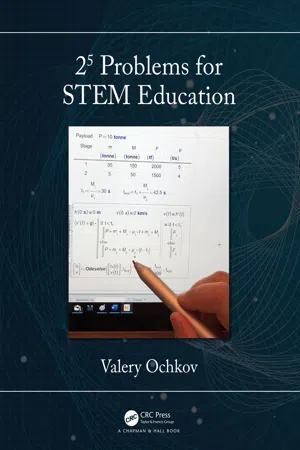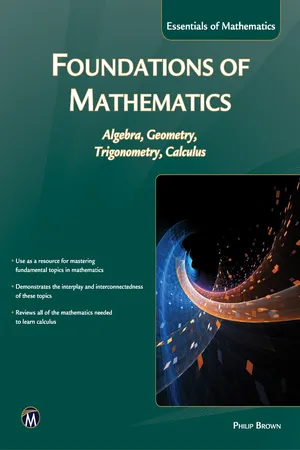Mathematics
Parabola
A parabola is a U-shaped curve that can be represented by a quadratic equation. It is symmetrical and has a vertex, which is the highest or lowest point on the curve. Parabolas are commonly found in algebra and geometry and are used to model various real-world phenomena, such as the path of a thrown object or the shape of a satellite dish.
Written by Perlego with AI-assistance
Related key terms
Related key terms
1 of 4
Related key terms
1 of 3
3 Key excerpts on "Parabola"
- eBook - ePub
- Valery Ochkov(Author)
- 2020(Publication Date)
- Chapman and Hall/CRC(Publisher)
The calculations in Figure 20.7 gave not a hyperbola, but a Parabola, which has another non-optical geometric interpretation. If a straight line is drawn on the plane and a point is placed near it, then the Parabola is the geometric locus of points equidistant from the given line (called the Parabola directrix) and a given point (called the focus of a Parabola). Hyperbolas, Parabolas and ellipses, which are not considered in this Study, are called conic curves since they are obtained by cutting a straight circular cone with a plane. By the way, celestial bodies move along elliptical, parabolic and hyperbolic orbits (see Study 9), followed by mirror and lens telescopes. In the faculty of mathematics much attention is paid to the transformation of these curves to the canonical form, which has not six (see Figures 20.3 and 20.7 above), but only two (hyperbola and ellipse) or even one (Parabola, circle, as a special case of the ellipse) coefficients. Note A Parabola, or rather, a paraboloid (the surface obtained by rotating the Parabola around an axis perpendicular to the directrix and passing through the focus) can be seen not only on the walls of houses where satellite TV is watched, but also in winter on ice slides. The fact is that, once upon a time, one Soviet plant manufacturing such antennas for the needs of the military was commissioned to manufacture and convert some products. The management of the plant thought for a short time and decided to attach two leather hinges to this plate (antenna). It became very cold. And here is another possible consumer good with a “Parabola inside”, the idea of another “art object”: a glass or a porcelain vase for fruit in the form of a paraboloid, with a round stand-head and the stem piercing in the center of the paraboloid and ending with the handle in the focus. Such a vase will look good in a mathematician’s house—lest they will have nothing to talk about with the guests at the table - eBook - ePub
Foundations of Mathematics
Algebra, Geometry, Trigonometry and Calculus
- Philip Brown(Author)
- 2016(Publication Date)
- Mercury Learning and Information(Publisher)
double cone. As long as the plane does not pass through the vertex of the cone, the boundary of the conic section is an ellipse, a Parabola, or a hyperbola.Any ellipse, Parabola, or hyperbola can be expressed as a Cartesian equation. In their most basic form, these equations are:•••The graphs of an ellipse, a Parabola, and a hyperbola are shown in figures 2.13 and 2.14 . The geometrical properties of each of these curves can be explained in terms of a certain point (or points) called the focus (or foci).FIGURE 2.13. The ellipse and the Parabola.FIGURE 2.14. The hyperbola.An ellipse, as defined above, has one focus at point F1 (c,0) and another focus at point F2 (−c,0), where The graph of an ellipse is the set (or graph) of all points P(x, y) in the plane with the property that the sum of the distances from P to each focus is the constant value 2a, that is, all coordinate pairs P(x, y), such that |PF1 | + |PF2 | = 2a. The constants a and b, respectively, determine the width and height of the ellipse. Note that if a = b = 1, then the ellipse is a circle.The graph of a Parabola is the set (or graph) of all points in the plane that are equidistant from the focus F(0, p) and the horizontal line y = −p, that is, all coordinate pairs P(x, y), such that |PF| = y + p. The constant p determines the width of the Parabola.A hyperbola has two branches. The focus of one branch is at the point F1 (c,0) and the focus of the other branch is at the point F2 (−c, 0), where The graph of a hyperbola is the set of all points in the plane with the property that the difference of the distances from the point to each focus is the constant value ±2a, that is, all coordinate pairs P(x,y), such that |PF1 | − |PF2 | = ±2a. A point P(x, y) is on the left branch or right branch of the hyperbola depending on whether the plus or the minus sign is taken on the right-hand side of this equation. The two straight lines shown in figure 2.14 are asymptotes for the hyperbola, that is, lines that the graph of the hyperbola gradually approaches as x - eBook - ePub
- Michael Harrison, Patrick Waldron(Authors)
- 2011(Publication Date)
- Routledge(Publisher)
L). This curve is called:- an ellipse when 0 < ϵ < 1;
- a Parabola when ϵ = 1;
- a hyperbola when ϵ > 1; and
- a circle as ϵ → 0, as we shall see later.
4.2.1 Parabola
Consider first the case of ϵ = 1, i.e. the Parabola. The equation of the Parabola takes its simplest form when the focus S is a point on the positive x axis, say (a, 0), where a > 0, and the directrix is the vertical line with equation x = −a. An example of a Parabola is shown in Figure 4.1 .Figure 4.1 Parabola with focus (a, 0) and directrix x = −aBy Pythagoras’s theorem, the square of the distance of P from the focus S is (x −a)2 + y2 and the square of the distance of P from the directrix L is (x + a)2 . Thus the equation of this Parabola is(4.1) which simplifies to+(2x − a)y 2=(2x + a)(4.2) Note that, when x is negative, y is imaginary, so the graph of the Parabola must lie entirely to the right of the y axis. When x = 0, then y = 0, so the graph just touches the y axis at the origin (0, 0), which is called the vertex of the Parabola. Finally, for each value of x > 0, there are two possible values of y, namelyy 2= 4 a x± 2. Thus the Parabola is symmetric about the x axis, which is also called the axis of the Parabola.a xSimilarly, a < 0 yields a Parabola tangential to but entirely to the left of the y axis.Note that, for any value of the real parameter t, the point (at2 , 2at) lies on the Parabola. Expressing the typical point on the Parabola in this form often simplifies the solution of related problems.By a simple change of coordinates, it can be seen that the equation of a Parabola with vertex at (α, β), focus at (α + a, β) and directrix x = α − a is(4.3) or= 4 a(2y − β)(x − α)x = α +(4.4)14 a(2y − β)4.2.2 Ellipse
Consider now the case of 0 < ϵ < 1, i.e. the ellipse. The equation of the ellipse takes its simplest form when the focus S is a point on the negative x axis, say( −aϵ, 0), where a > 0, and the directrix is the vertical line with equation x =−a/ϵ. Such an ellipse is depicted in Figure 4.2
Index pages curate the most relevant extracts from our library of academic textbooks. They’ve been created using an in-house natural language model (NLM), each adding context and meaning to key research topics.
Explore more topic indexes
Explore more topic indexes
1 of 6
Explore more topic indexes
1 of 4


